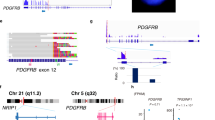Abstract
PAX5-KIDINS220 (PAX5-K220) is a novel chimeric fusion gene identified in a pediatric Philadelphia chromosome (Ph)-like acute lymphoblastic leukemia (ALL) patient, but the function of the encoded fusion protein has not yet been analyzed. Here, we report the functional analysis of PAX5-K220 in vitro. We successfully generated PAX5-K220 expressing cells and demonstrate that PAX5-K220 is a nuclear protein. Luciferase reporter assay reveals that PAX5-K220 inhibits wild-type PAX5 transcriptional activity in a dominant-negative fashion like other PAX5-related fusion proteins, and may contribute to lymphocyte differentiation block. However, although identified in Ph-like ALL, PAX5-K220 does not induce IL-3-independent proliferation when transduced in the IL-3-dependent Ba/F3 murine leukemia cells, but rather attenuates growth. These results reveal that PAX5-K220 certainly shares the character with other PAX5-related fusion proteins rather than other fusion proteins with tyrosine kinase activity identified in Ph-like ALL, and did not contribute to proliferation activity. Precise functional analysis of each differently partnered PAX5 fusion protein is warranted in the future for better understanding of PAX5-related translocations and their effects.




Similar content being viewed by others
References
Coyaud E, Struski S, Prade N, Familiades J, Eichner R, Quelen C, et al. Wide diversity of PAX5 alterations in B-ALL: a groupe francophone de cytogenetique hematologique study. Blood. 2010;115(15):3089–97.
Nebral K, Denk D, Attarbaschi A, Konig M, Mann G, Haas OA, et al. Incidence and diversity of PAX5 fusion genes in childhood acute lymphoblastic leukemia. Leukemia. 2009;23(1):134–43.
Bousquet M, Broccardo C, Quelen C, Meggetto F, Kuhlein E, Delsol G, et al. A novel PAX5-ELN fusion protein identified in B-cell acute lymphoblastic leukemia acts as a dominant negative on wild-type PAX5. Blood. 2007;109(8):3417–23.
Fazio G, Palmi C, Rolink A, Biondi A, Cazzaniga G. PAX5/TEL acts as a transcriptional repressor causing down-modulation of CD19, enhances migration to CXCL12, and confers survival advantage in pre-BI cells. Cancer Res. 2008;68(1):181–9.
Kawamata N, Pennella MA, Woo JL, Berk AJ, Koeffler HP. Dominant-negative mechanism of leukemogenic PAX5 fusions. Oncogene. 2012;31(8):966–77.
Kurahashi S, Hayakawa F, Miyata Y, Yasuda T, Minami Y, Tsuzuki S, et al. PAX5-PML acts as a dual dominant-negative form of both PAX5 and PML. Oncogene. 2011;30(15):1822–30.
Schinnerl D, Fortschegger K, Kauer M, Marchante JR, Kofler R, Den Boer ML, et al. The role of the Janus-faced transcription factor PAX5-JAK2 in acute lymphoblastic leukemia. Blood. 2015;125(8):1282–91.
Sakamoto K, Imamura T, Kanayama T, Yano M, Asai D, Deguchi T, et al. Ph-like acute lymphoblastic leukemia with a novel PAX5-KIDINS220 fusion transcript. Genes Chromosomes Cancer. 2017;56(4):278–84.
Iglesias T, Cabrera-Poch N, Mitchell MP, Naven TJ, Rozengurt E, Schiavo G. Identification and cloning of Kidins220, a novel neuronal substrate of protein kinase D. J Biol Chem. 2000;275(51):40048–56.
Arevalo JC, Yano H, Teng KK, Chao MV. A unique pathway for sustained neurotrophin signaling through an ankyrin-rich membrane-spanning protein. EMBO J. 2004;23(12):2358–68.
McNiece IK, Bradley TR, Kriegler AB, Hodgson GS. A growth factor produced by WEHI-3 cells for murine high proliferative potential GM-progenitor colony forming cells. Cell Biol Int Rep. 1982;6(3):243–51.
Morita S, Kojima T, Kitamura T. Plat-E: an efficient and stable system for transient packaging of retroviruses. Gene Ther. 2000;7(12):1063–6.
Fujiki A, Imamura T, Sakamoto K, Kawashima S, Yoshida H, Hirashima Y, et al. All-trans retinoic acid combined with 5-Aza-2’-deoxycytidine induces C/EBPalpha expression and growth inhibition in MLL-AF9-positive leukemic cells. Biochem Biophys Res Commun. 2012;428(2):216–23.
Yoshida H, Imamura T, Fujiki A, Hirashima Y, Miyachi M, Inukai T, et al. Post-transcriptional modulation of C/EBPalpha prompts monocytic differentiation and apoptosis in acute myelomonocytic leukaemia cells. Leuk Res. 2012;36(6):735–41.
Tomii T, Imamura T, Yano M, Sakamoto K, Kato I, Tanaka K, et al. Leukemic cell expressing a novel kinase fusion protein NCOR1-LYN exhibits high sensitivity to Dasatinib and Rapamycin. Blood. 2018;132(Supplement 1):1557–1557.
Gu Z, Churchman ML, Roberts KG, Moore I, Zhou X, Nakitandwe J, et al. PAX5-driven subtypes of B-progenitor acute lymphoblastic leukemia. Nat Genet. 2019;51(2):296–307.
Liang X, Gu J, Li T, Zhao L, Fu X, Zhang W, et al. PAX5 haploinsufficiency induce cancer cell dormancy in Raji cells. Exp Cell Res. 2018;367:30–6.
Jamrog L, Chemin G, Fregona V, Coster L, Pasquet M, Oudinet C, et al. PAX5-ELN oncoprotein promotes multistep B-cell acute lymphoblastic leukemia in mice. Proc Natl Acad Sci USA. 2018;115(41):10357–62.
Smeenk L, Fischer M, Jurado S, Jaritz M, Azaryan A, Werner B, et al. Molecular role of the PAX5-ETV6 oncoprotein in promoting B-cell acute lymphoblastic leukemia. EMBO J. 2017;36(6):718–35.
Ebinger S, Ozdemir EZ, Ziegenhain C, Tiedt S, Castro Alves C, Grunert M, et al. Characterization of rare, dormant, and therapy-resistant cells in acute lymphoblastic leukemia. Cancer Cell. 2016;30(6):849–62.
Funding
This work was supported by grants-in-aid for scientific research from the Japanese Ministry of Education, Culture, Sports, Science and Technology (17K10124) and a grant from the Japan Agency for Medical Research and Development (17ck0106253h0001).
Author information
Authors and Affiliations
Corresponding author
Ethics declarations
Conflict of interest
The authors have no conflicts of interest to declare.
Additional information
Publisher's Note
Springer Nature remains neutral with regard to jurisdictional claims in published maps and institutional affiliations.
About this article
Cite this article
Kanayama, T., Imamura, T., Mayumi, A. et al. Functional analysis of a novel fusion protein PAX5-KIDINS220 identified in a pediatric Ph-like ALL patient. Int J Hematol 112, 714–719 (2020). https://doi.org/10.1007/s12185-020-02944-4
Received:
Revised:
Accepted:
Published:
Issue Date:
DOI: https://doi.org/10.1007/s12185-020-02944-4




